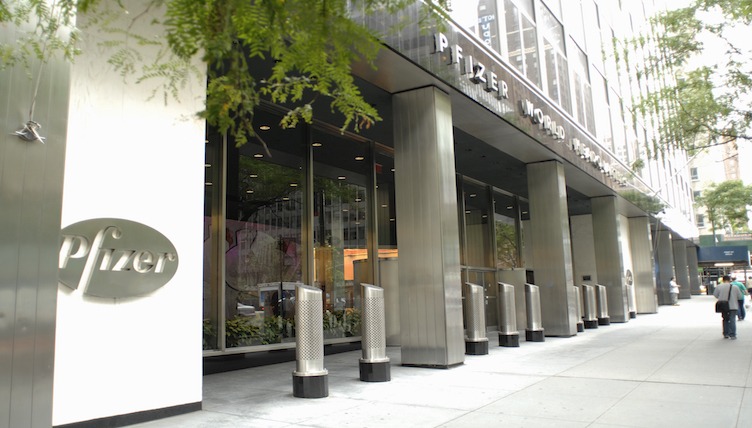What May Be in Store for Pfizer?
Potential mega-mergers put Pfizer in the headlines over the past several years, but will that be the strategy of the company going forward? DCAT Value Chain Insights takes an inside look..
Pfizer’s proposed $160-billion acquisition of Allergan in 2016 and its proposed $118 billion proposal for a takeover of AstraZeneca in 2014, two deals that eventually did not come to fruition, would have been the largest acquisitions in pharmaceutical industry history. What has Pfizer done since then to build its pipeline and commercial portfolio and what have been the results thus far?
A look at the numbers
After pursuing mega-mergers that did not materialize, Pfizer recently has focused on smaller-scale acquisitions and organic growth to fuel is revenue growth. Key recent acquisitions included: the $17-billion acquisition of Hospira in 2015; the $14-billion acquisition of Medivation in 2016; the $5.2 billion acquisition of Anacor Pharmaceuticals in 2016; and most recently, the $1.6-billion acquisition of AstraZeneca’s small-molecule anti-Infectives business, a deal that closed in December 2016.
So what have been the results? In 2016, Pfizer reported total revenues of $52.82 billion, an 8% gain year over year, from $48.85 billion in 2015. Pfizer manages its commercial operations through two distinct businesses: Pfizer Innovative Health (IH) (formerly, the Innovative Products business) and Pfizer Essential Health (EH) (formerly the Established Products business). Its IH business posted revenues of $29.20 billion, up 9% year over year, and its EH business had 2016 revenues of $23.63 billion, up 7% year over year.
 |
| Ian Read Chairman and CEO Pfizer |
“I was pleased with the company’s overall performance during 2016 and believe both of our businesses executed well despite a challenging operating environment,” said Ian Read, chairman and chief executive officer, Pfizer, in a company statement in commenting on the results. “We generated attractive operational revenue and earnings growth driven by our major products within both the Innovative Health and Essential Health businesses. In addition to strong business performance, we allocated our shareholders’ capital to a variety of value-creating initiatives that included company and product portfolio acquisitions, share repurchases, an increase in our dividend and ongoing funding for our R&D and commercial organizations.”
Key performers in the company’s IH business in 2016 were: Lyrica (pregabalin), a drug to treat neuropathic pain conditions, fibromyalgia, and as an adjunctive therapy for adult patients with partial onset seizures, with sales of $4.2 billion, Ibrance (palbociclib), a drug for treating breast cancer, with sales of $2.1 billion; Enbrel (etanercept), an autoimmune drug, with sales of $2.9 billion (sales outside the US and Canada); Viagra (sildenafil), a drug to treat erectile dysfunction, with sales of nearly $1.2 billion; Sutent (sunitinib), a drug for treating gastrointestinal stromal tumors and advanced renal cell carcinoma, with sales of $1.1 billion; and its vaccine family Prevnar/Prevenar 13 for pneumococcal pneumonia with sales of $5.7 billion.
Assessing recent deals
Pfizer’s largest acquisition in 2016 was the $14-billion acquisition of Medivation, a San Francisco-based biopharmaceutical company, which boosted the company’s oncology portfolio. The key gain for Pfizer was Medivation’s prostate cancer drug, Xtandi (enzalutamide), for which Medivation is partnered with Astellas Pharma and which posted $2 billion-plus in overall annual revenues. The drug is also in development for two-late stage studies, one for treating non-metastatic prostate cancer and another study in hormone-sensitive prostate cancer. It is also being further developed in Phase II studies for the potential treatment of advanced breast cancer and hepatocellular carcinoma. With the acquisition of Medivation. Pfizer also gained has a late-stage oncology pipeline, which includes two development-stage oncology assets, talazoparib and pidilizumab. Talazoparib is in late-stage development for treating BRCA-mutated breast cancer, and pidilizumab is an immuno-oncology asset being developed for treating diffuse large B-cell lymphoma and other hematologic malignancies and has the potential to be combined with immuno-oncology therapies in Pfizer’s portfolio.
Pfizer’s oncology pipeline, immuno-oncology assets, in particular avelumab, an investigational fully human anti-PD-L1 IgG1 monoclonal antibody, are key for Pfizer. Avelumab is part of the immunotherapy alliance that Pfizer and Merck KGaA formed in November 2014 under which the companies will collaborate on up to 20 high priority immuno-oncology clinical development programs, including combination trials. The clinical development program for avelumab involves study of more than 15 tumor types, including breast cancer, gastric/gastroesophageal cancer, head and neck cancer, Merkel cell carcinoma (an aggressive form of skin cancer), mesothelioma, melanoma, non-small cell lung cancer, ovarian cancer, renal cell carcinoma, and urothelial (e.g. bladder) cancer. In November 2016, that the US Food and Drug Administration accepted for priority review a biologics license application for avelumab seeking approval for use in patients with metastatic Merkel cell carcinoma,
With its $5.2-billion acquisition of Anacor, Pfizer gained Anacor’s flagship asset, crisaborole, a differentiated non-steroidal topical PDE4 inhibitor with anti-inflammatory properties, which was approved in December 2016 for the treatment of mild-to-moderate atopic dermatitis, commonly referred to as eczema. Anacor also held the rights to Kerydin, a topical treatment for onychomycosis (toenail fungus) that is distributed and commercialized by Sandoz Inc. in the US. Kerydin was approved by the FDA in 2014. In July 2014, Anacor entered into an exclusive agreement with Sandoz to which PharmaDerm, the branded dermatology division of Sandoz, distributes and commercializes Kerydinin in the United States.
Overall, Pfizer’s current pipeline contains 96 clinical programs, half biologics and half small molecules,of which approximately two-thirds are new molecular entities, noted Pfizer in an investor presentation in January 2017.
Pfizer is positioning its Essential Health business to return to sustainable growth over the next few years driven by the sterile injectables and biosimilars businesses and anticipated continued growth in emerging markets. The business was bolstered with the $17-billion acquisition of Hospira in 2015, the 2015 acquisition of Innopharma (a sterile injectables generic drug manufacturer), and the 2016 acquisition of AstraZeneca’s small-molecule anti-infectives business. In 2016, Pfizer decided to keep its EH business and IH business combined into one company after evaluating whether to split its EH (or established products business) into a separate company.
A retreat from mega-mergers?
These smaller and more targeted acquisitions follow two mega mergers that did not materialize. In April 2016, Pfizer and Allergan called off their proposed $160-billion merger citing the US Department of Treasury’s issuance of temporary and proposed regulations to further reduce the benefits of and limit the number of corporate inversions, a move that the companies said created an adverse tax law change. Pfizer’s proposed $160 billion merger with the Dublin, Ireland-based Allergan, which the companies announced in November 2015, would have been the largest merger in the history of the pharmaceutical industry. Pfizer’s decision to pursue Allergan followed its interest in acquiring AstraZeneca in 2014, another mega merger for Pfizer that did not come to fruition. Pfizer announced in late May 2014 that it would not make a formal offer to acquire AstraZeneca following AstraZeneca’s decision to reject Pfizer’s non-binding $118-billion proposal. Pfizer’s interest in acquiring AstraZeneca was to build its pipeline and commercial portfolio, but it also had a financial component in establishing a new UK-incorporated holding company of the proposed combined company. The proposal for the deal brought to the fore the issue of corporate inversion, a practice by which a US-based multinational company restructures so that the US parent is replaced by a foreign corporation as a means to achieve a lower tax rate.






